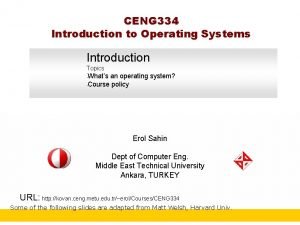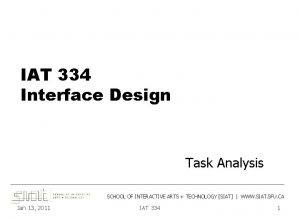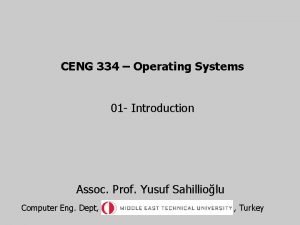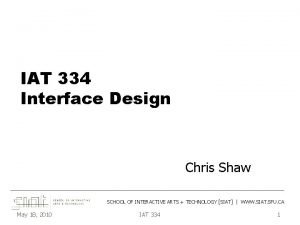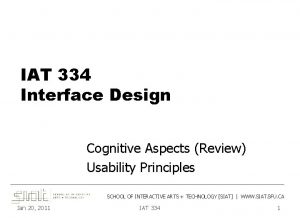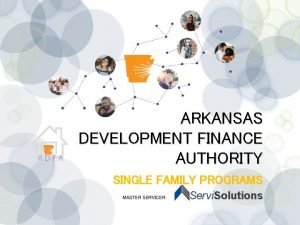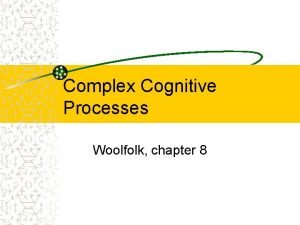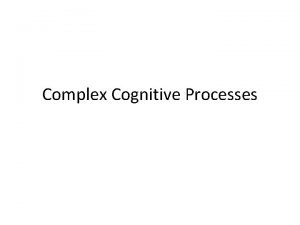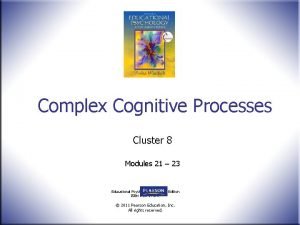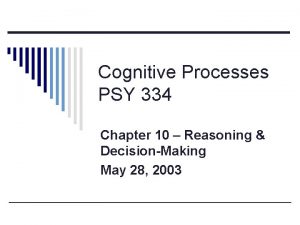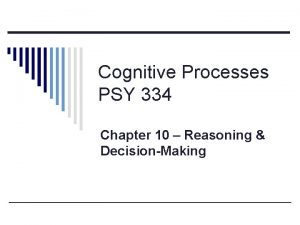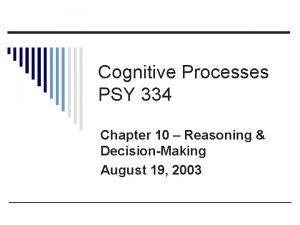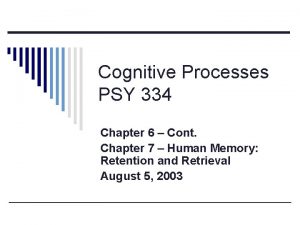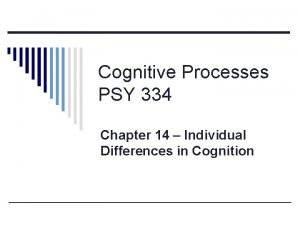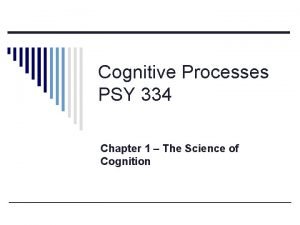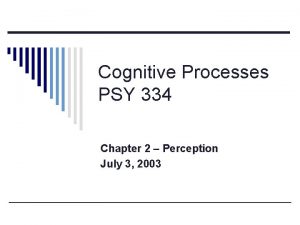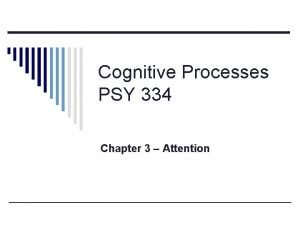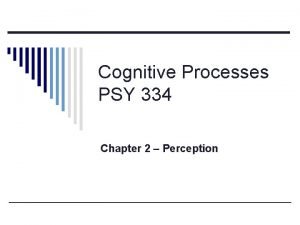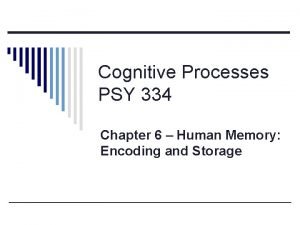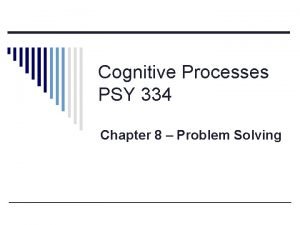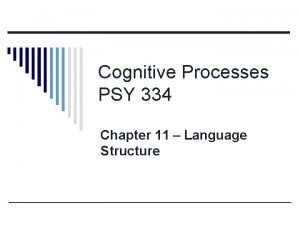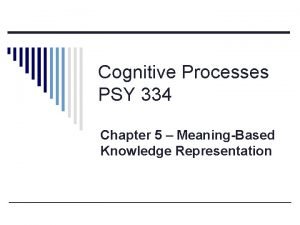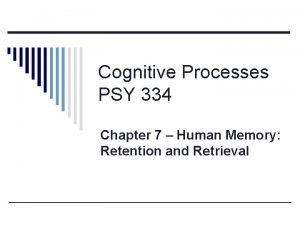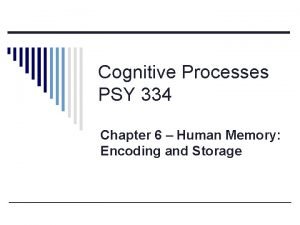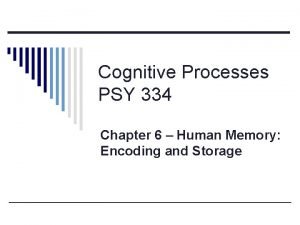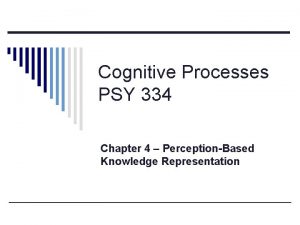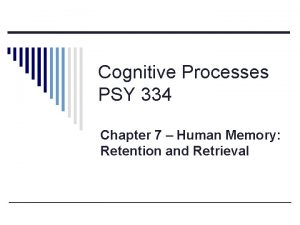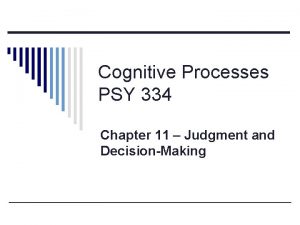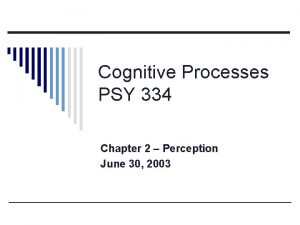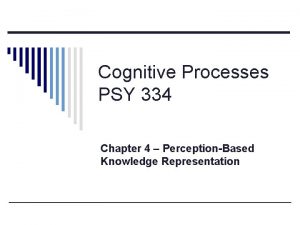Cognitive Processes PSY 334 Chapter 10 Reasoning Midterm























- Slides: 23

Cognitive Processes PSY 334 Chapter 10 – Reasoning

Midterm 2 Results

Logic vs Human Reasoning o Logic – a subdiscipline of philosophy and mathematics that formally specifies what it means for an argument to be correct. n Human deviations from logic were thought to be malfunctions of the mind. o AI systems guided by logic are also deficient, lacking common sense. o Prescriptive or normative models do not predict human behavior very well.

Demos of Human Irrationality o Four main areas of research have studied how humans deviate from prescriptive models: n n Reasoning about conditionals Reasoning about quantifiers Reasoning about probabilities Decision making

Two Kinds of Reasoning o Reasoning – the process of inferring new knowledge from what we already know. o Deductive reasoning – conclusions follow with certainty from their premises. n Reasoning from the general to the specific. o Inductive reasoning – conclusions are probable (likely) rather than certain. n n Reasoning from the specific to the general. Probabilistic – based on likelihoods.

Syllogisms o Syllogism – a series of premises followed by a logical conclusion. o All poodles are pets Congruent 84% All pets have names. : All poodles have names – T or F? All pets are poodles Incongruent 74% All poodles are vicious. : All pets are vicious -- T or F?

Content-Free (Abstract) o Subjects did better judging syllogisms that were consistent with reality (congruent). o Content-free syllogisms use symbols instead of meaningful sentences: All P are B Abstract 77% All B are C. : All P are C – T or F?

Conditionals o If-then statements. n n Antecedent – the “if” part. Consequent – the “then” part. o Rules of inferences using conditionals: n n n Modus ponens -- If A then B, observe A, conclude B Modus tollens – If A then B, observe not-B, conclude not-A Notation: negation, implication, therefore.

Modus Ponens and Tollens o If Joan understood this book, then she would get a good grade. If P then Q n n Joan understood. : she got a good grade. This uses modus ponens. P. : Q o If Joan understood this book, then she would get a good grade. If P then Q n n She did not get a good grade. : she did not understand this book. ~Q. : ~P This uses modus tollens.

Logical Fallacies o Denial of the antecedent: n If P then Q, not-P, conclude not-Q n If P then Q, not-P, conclude Q o Affirmation of the consequent: n If P then Q, Q, conclude P n If P then Q, Q, conclude not-P o Subjects seem to interpret the conditional as a biconditional – “if” means “if and only if”

Denial of the Antecedent o If Joan understood this book, then she would get a good grade. If P then Q n n Joan did not understand. : she got a bad grade. – This is not necessarily true. This is a fallacy. ~P. : ~Q o If it rains, then I will carry an umbrella. n n It is not raining. : I will not carry an umbrella. But I may carry an umbrella for shade!

Affirmation of the Consequent o If Joan understood this book, then she would get a good grade. If P then Q n n Joan got a good grade. : she understood the book. This is not necessarily true. This is a fallacy. Q. : P o If someone is abused as a child, then they will show certain symptoms. n They show symptoms. : They were abused as a child. Symptoms may not be of abuse!

How People Reason o People may be reasoning in terms of conditional probabilities. n Conditional probabilities can be found that correspond to acceptance rates for fallacies. o Wason selection task – if there is a vowel on one side, then there must be an even number on the other side. n n Can be explained in terms of probabilities. Also explained by a permission schema

Sample Wason Task E E K 4 7 87% 16% 62% 25% K 4 7 Affirming the consequent Failure to apply modus tollens

A Contextualized Version o In order to drink beer, someone must be 21 years of age: DRINKING A BEER DRINKING A COKE 22 YEARS OF AGE Which ones would you check? 16 YEARS OF AGE

Explanations o Three proposed theories: n n n Logic – people routinely fail to apply modus tollens. Probabilistic – this tasks produces failures only with certain underlying probabilities. Permission schema – the logical connective is interpreted in terms of social contract. o A cheating context improves the results.

Quantifiers o Categorical syllogism – analyzes propositions with quantifiers “all, ” “no, ” and “some. ” o Fallacies: Some A’s are B’s Some B’s are C’s Conclude: Some A’s are C’s o Some women are lawyers, some lawyers are men, conclude some women are men.

Atmosphere Hypothesis o People commit fallacies because they tend to accept conclusions with the same quantifiers as the premises. n n n No A’s are B’s All B’s are C’s Conclude No A’s are C’s. o Universal premises go with universal conclusions, particular with particular. o Does not fully explain behavior.

Two Forms of Atmosphere o People tend to accept a positive conclusion to positive premises, negative conclusion to negative premises. n Mixed premises lead to negative conclusions. o People tend to accept universal conclusions from universal premises (all, no), particular conclusions from particular premises (some, some not).

Limitations o Atmosphere hypothesis describes what people do, but doesn’t explain why. o People violate predictions of the atmosphere hypothesis. n n More likely to accept a syllogism if it contains a chain leading from A to C. People should accept a syllogism with two negative premises, but correctly reject it.

Process Explanations o People construct a mental model to think concretely about the situation. o Correct conclusions depend upon choosing the correct mental model. o Errors occur because people overlook possible explanations of the premises: n n n All the squares are shaded Some shaded objects have bold borders. . : Some of the squares have bold borders.

Possible Interpretations Is it this way? Or this?

Possible Meanings All A are B A Some A are B A B No A are B A AB B B A B AB A A B B
 Cognitive and non cognitive religious language
Cognitive and non cognitive religious language Ceng334
Ceng334 Iat 334
Iat 334 Ceng334
Ceng334 Iat 334
Iat 334 Ablmcc scy
Ablmcc scy Love story 334
Love story 334 Learnability flexibility robustness
Learnability flexibility robustness 8663392432
8663392432 Complex cognitive processes definition
Complex cognitive processes definition Complex cognitive processes
Complex cognitive processes How do we learn complex processes
How do we learn complex processes Complex cognitive processes
Complex cognitive processes Concurrent processes are processes that
Concurrent processes are processes that Nductive reasoning
Nductive reasoning Deductive reasoning
Deductive reasoning Inductive reasoning vs deductive reasoning
Inductive reasoning vs deductive reasoning Every quiz has been easy. therefore, the test will be easy.
Every quiz has been easy. therefore, the test will be easy. Every quiz has been easy. therefore the quiz will be easy
Every quiz has been easy. therefore the quiz will be easy Patterns and inductive reasoning
Patterns and inductive reasoning Examples of inductive argument
Examples of inductive argument Euro psy
Euro psy Ucf psychology major
Ucf psychology major Psy2055
Psy2055

